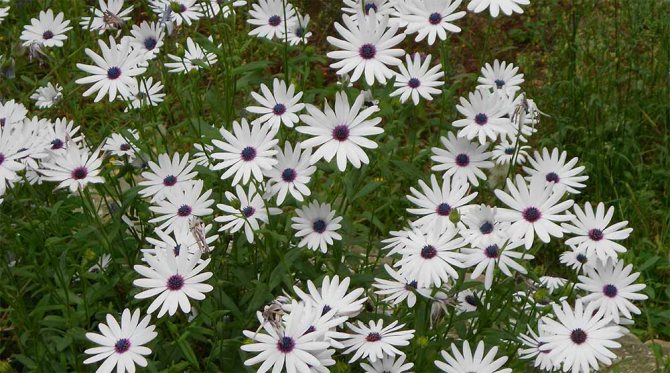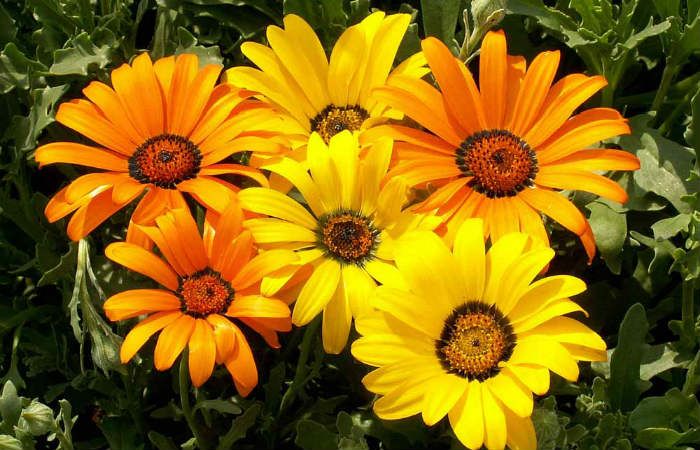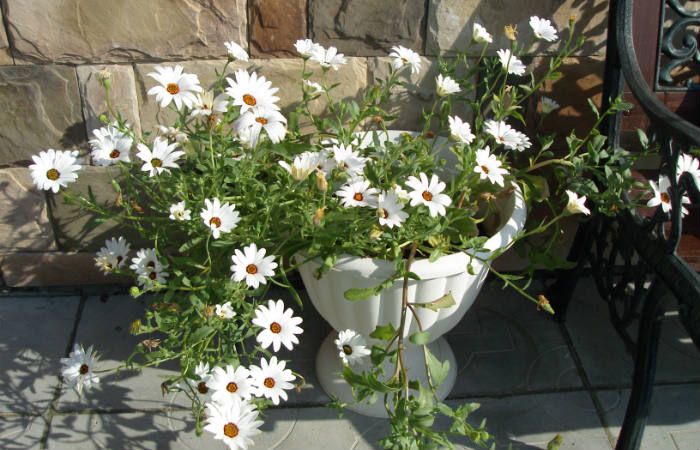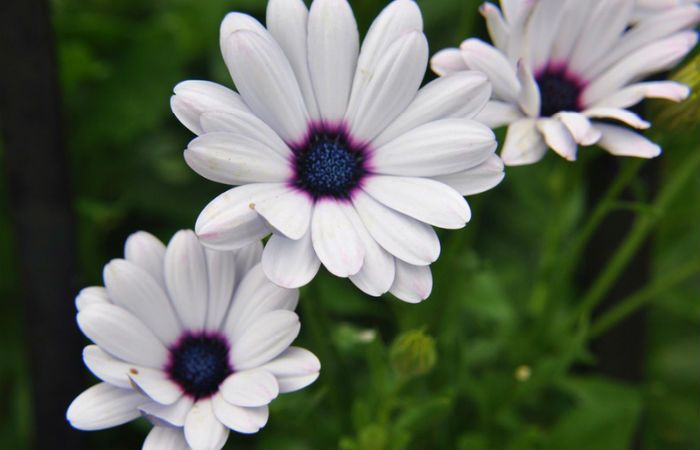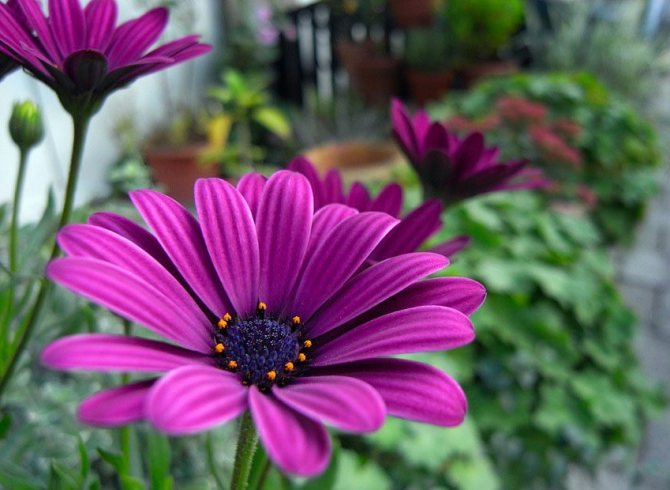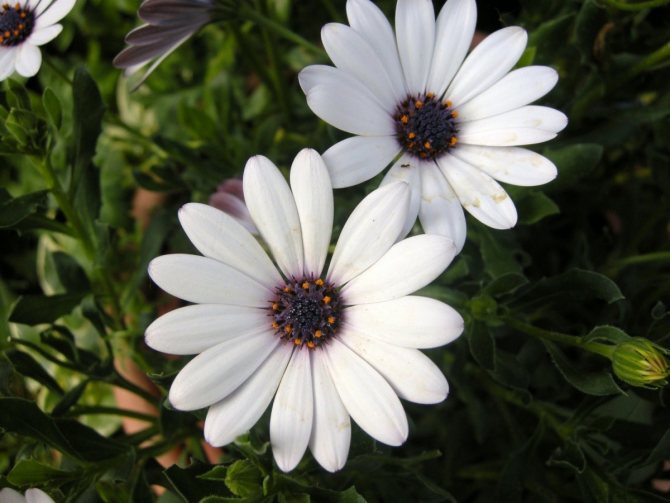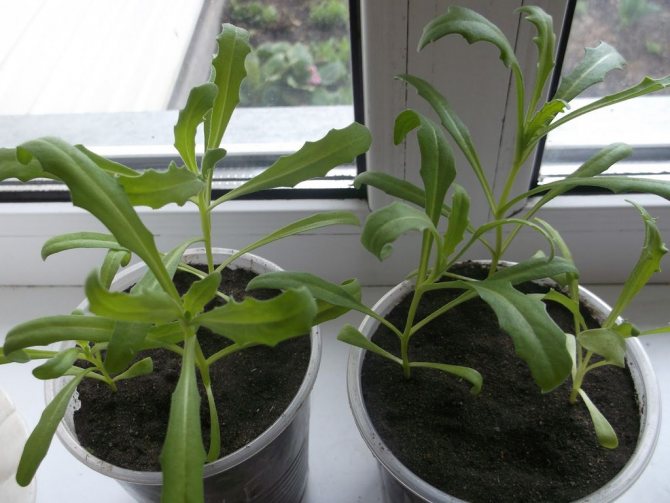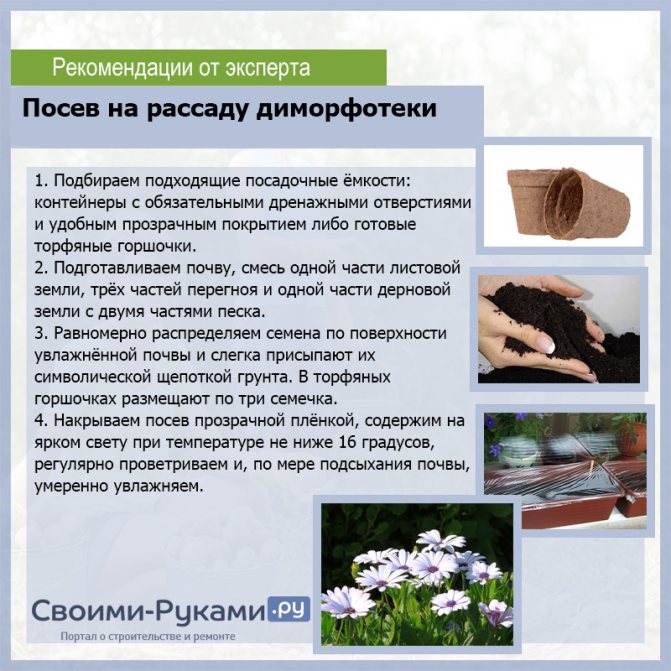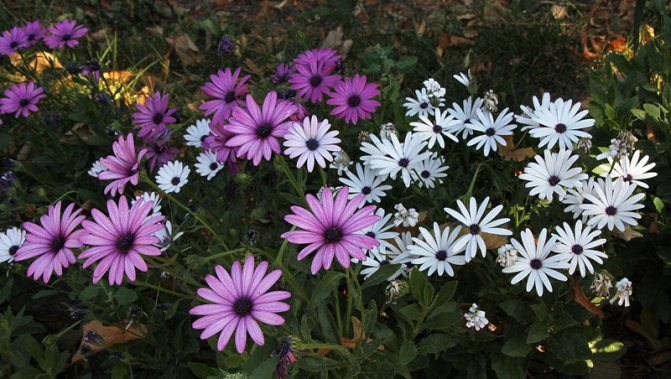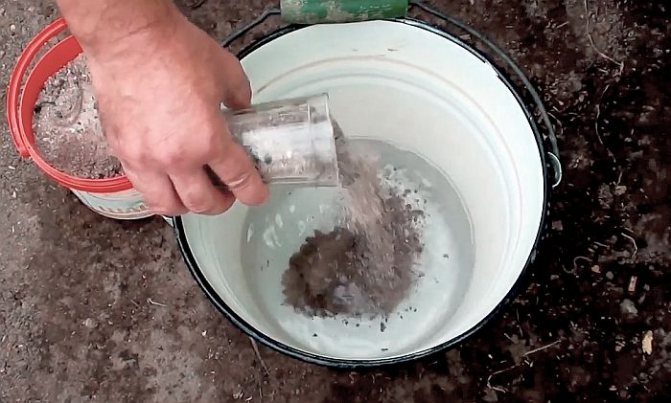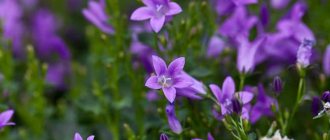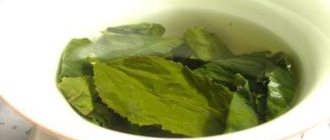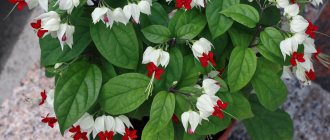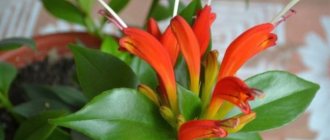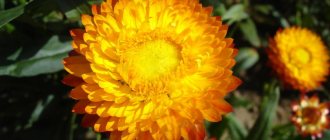Description and the best varieties
Dimorphoteka is a perennial plant that is almost universally cultivated in our country as an annual. This is due to the fact that the flower is native to South Africa and our harsh conditions may not be to its liking.
The height of the stems of the dimorphoteca ranges from 30-60 cm, the leaf plates are opposite and elongate-lanceolate, not terry baskets are formed singly, their diameter usually does not exceed 10 cm. There are two types of flowers - tubular and ligulate.
African moon
Herbaceous annual plant, the height of climbing stems which does not exceed 45 cm, dense foliage. The flowers are basket-shaped, rather large, about 8 cm in diameter, the color of the petals is rich orange, about 25 inflorescences can form on one copy. It will be possible to observe abundant flowering during the period from June to September. The variety is drought-resistant, but does not tolerate frost well.
Ballet
Low-growing plant, strongly branched stem, creeping. It begins to bloom 40-50 days after sowing the planting material in the ground. The inflorescences have a white color, and the center of the flower is dark blue, the diameter of the basket is 6 cm, it blooms for a long time and abundantly, the inflorescences close at night and cloudy weather.
Julia
The plant is grown as an annual, its height reaches 40 cm, the leaf plates are elongated, the stem is highly branching. The color of the inflorescences is white, with a dark brown center, in diameter they can reach 7 cm. The first shoots hatch 14-20 days after sowing in the ground, flowering is long.
Rain
Herbaceous annual plant, erect stem, its height varies from 20 to 40 cm, the bush has a hemispherical shape, branched, with elongated leaf plates. Peduncles are long, the color of the upper side of the petals is cream or white, and the lower one is purple; tubular petals of yellow-brown color are formed in the center. The inflorescences smell good, the flowering is abundant.
Starlight
The plant is a herbaceous annual, its height varies within 35-50 cm, the bushes are formed in the form of a ball, the stems are strong, branched. The flowers are large, their diameter can reach 7-9 cm, the color of the petals is pale pink. Abundant flowering can be admired after June 10-15 and before the start of frost. The variety tolerates drought well, but is not resistant to cold weather.
Caravan
A medium-sized plant, a bush can grow up to 45 cm in height, leaf plates are dark green in color, their shape is elongated. The size of the inflorescences in the form of baskets is from 6 to 8 cm in diameter, the ligulate petals are of white, orange and cream shades, and the center is dark brown with tubular petals. On light soils, it blooms for a long time and is quite abundant, starting from the beginning of the summer period.
Coconut ice
The cultivar can be grown as a perennial, as the plant tolerates cold and dry weather well. The height of strong stems can reach 45-60 cm, the inflorescences are large, their diameter is 7-10 cm, the petals are dazzling white with a dark blue center in the form of a disk. Abundant flowering can be observed from mid-June to late autumn.
polar Star
An annual plant, a hemispherical bush is completely covered with graceful inflorescences, branchy, densely leafy stems. The flowers are large, in the form of baskets, the color of the petals is white, and the center of the inflorescences is dark brown, so they resemble chamomile. The variety tolerates dry weather and cold well, under normal conditions flowering lasts from June to the beginning of autumn frosts.
Snow Maiden
Herbaceous annual, forms a medium-sized bush about 35 cm high, its shape is hemispherical, densely leafy stems. The inflorescences are in the form of baskets of medium size (5-7 cm), the color of the petals is sparkling white, and the middle is dark purple. With sufficient light, flowering is abundant; it can be observed from June to September.
Tetra Goliath
It is grown as an annual plant, the bush is hemispherical, looks voluminous, many inflorescences are formed on long peduncles. The flowers in the form of baskets are impressive in size, their diameter can be 10 cm, the color of the petals is saturated, orange-golden. The abundant bloom can be enjoyed from June to the end of September.
Amber
The height of the plant usually does not exceed 45 cm, the bush is sprawling, hemispherical, in diameter it can reach half a meter, the stems are strong, branched, the foliage is average. On one specimen, up to 25 inflorescences of orange color with a dark middle are formed, on long peduncles. Abundant flowering for 40-60 days, the variety is drought-resistant.
Description of the flower
Dimorphotheca (Dimorphotheca) is a genus that unites 20 species of perennial and annual grasses and shrubs. In nature, it is found mainly in wet meadows and in the desert areas of the south of the African continent.
The botanical name for dimorphos is derived from the Latin words "dimporphos" - "two-form" and "theke" - "capacity". This name is due to two types of seeds that are formed in one inflorescence, completely different in shape. It is interesting that from both varieties grow plants identical in their morphological properties. Among flower growers, dimorphoteka is known as:
- Cape marigolds;
- Cape chamomile;
- African chamomile.
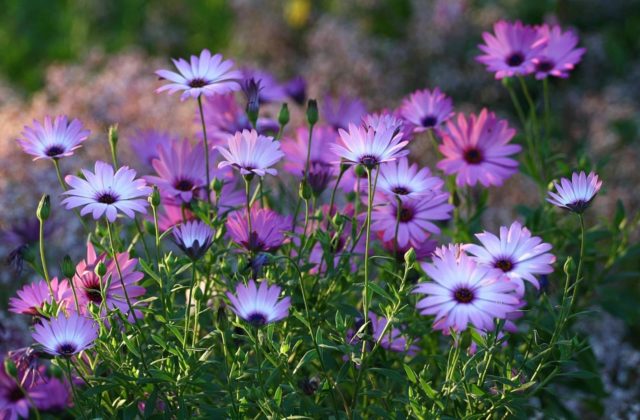
Dimorphoteka is a bush with branched or raised stems that grow up to 40 cm in height. The leaf plates are elongated and narrow, pinnately divided or dentate, in some species pubescence is noticeable. Dimorphic leaves are arranged alternately or collected in the form of a rosette, in the lower part of the bush.
In its natural environment, dimorphoteka grows on loose soils with a large number of stones and gravel. In view of this, the rhizome of the plant has the form of a powerful rod with fibrous processes at the end; it goes deep into the ground in order to be able to get to the moist layers and groundwater.
Dimorphoteka inflorescence is a single basket 6-8 cm in diameter, crowning a thin but strong peduncle. Flowers along the edges of the basket have an elongated shape in the form of a tongue; small tubular flowers are located in the core. The variety of petal colors is striking, the most common are:
- snow-white;
- bright yellow;
- peach;
- orange;
- burgundy;
- pink;
- lilac.
The center of the basket has a contrasting color in relation to the petals, it seems that it is velvety and shiny. The core of a dimorphoteca flower is usually colored in:
- dark brown;
- purple;
- yellow.
One inflorescence of the dimorphoteka retains freshness for 4-5 days, then withers, but it is immediately replaced by new numerous buds.
Comment! Dimorphoteca flower can predict the weather - its petals close shortly before the first raindrops.
To protect precious pollen from moisture, Dimorphoteka folds the petals into a bud every night and remains in this form on cloudy and rainy days. Dimorphoteka retains freshness well after cutting and is suitable for making bouquets.
Growing seedlings
Dimorphoteka seeds can be purchased or harvested by yourself. It is necessary to sow the planting material in a cold greenhouse or in containers that will be covered with transparent film or glass. The soil in containers should have the following composition: turf soil, sand and humus in a ratio of 1: 2: 3, everything must be mixed well and put in containers. It is not necessary to deeply deepen the seeds during sowing, it will be enough to sprinkle them with soil a little and compact it slightly, the soil should be moistened. If the air temperature in the room is 20 degrees Celsius, then the first shoots can hatch after 10 days. When the plant grows a little stronger, they dive into small separate pots, 2-3 pieces each. At the very end of May, when frosts are no longer expected, the flowers, along with a lump of earth, are planted in the ground according to the 25 × 25 scheme.
Planting seeds in open ground
Growing dimorphoteka in a seedless way is possible only in regions with a warm and mild climate. Seeds are sown on a flower bed from mid-May. To do this, make grooves or sow continuous, without deepening by more than 0.5 cm, the soil is moistened from a spray bottle. For faster germination, the flower bed is covered with foil. After 1-1.5 weeks, the first shoots will appear, which are thinned out as they grow, leaving the strongest and most viable plants. Flowering dimorphoteka with a seedless growing method occurs 2 weeks later.
Seedless way
Seedlings of dimorphoteka, if the root system is damaged, is very painful to transplant, therefore, quite often gardeners sow seeds directly into open ground. It is advisable to choose a place for a flower that is sunny, it can be protected from wind and drafts, although the plant feels good in open areas, the main thing is that there is no stagnation of water on the site. Before sowing, the soil must be moistened, since watering after it can wash out the planting material, the sown seeds are sprinkled with soil and compacted. When the seedlings grow a little, they need to be thinned so that the distance between individual specimens is 25 cm.
Dimorfoteka flowers, planting and care
Dimorphic flowers are a popular, like clarkia, annual for decorating urban flower beds and garden plots, not too demanding in care and choosing a planting site. For dimorphoteka, planting in poor soil is possible, as long as the place is sunny, without dampness and stagnant water. Flowers do not require too early preparation of seedlings and painstaking care. They can also be grown in a seedless way. When sowing in April for seedlings, dimorphoteka blooms at the end of June. After planting in the ground, the plants need minimal maintenance. They decorate flower beds until autumn. Graceful flowers on sturdy stems are suitable for cutting.
Flower bed preparation
It is desirable that the flowerbed set aside for the cultivation of dimorphoteka is well lit, but the flower can also grow in poorly shaded areas. This culture is unpretentious and can be cultivated on almost any type of soil, but light, loose and well-drained soil, for example, sandy, is considered the best option for it. If the soil in the flower garden is heavy, you can add humus and sand to it. The culture does not require special fertility, since a decrease in the abundance of flowering is observed on well-fertilized soils.
Landing requirements
For planting dimorphoteka, it is impossible to choose shady and swampy areas, salt marshes and acidic soils, damp relief depressions. We give preference to places with full sunlight, hills, southern slopes. Culture is not afraid of winds and drafts.
Plants love neutral soil, without stagnant moisture, loose and not too nutritious. With an excess of organic matter, greenery grows magnificently, but flowering is weak.We add sand to the loam and organize drainage, pour a little compost, wood ash and complex mineral fertilizer into the too poor soil. We place dimorphic seedlings in holes at a distance of 20 - 30 cm from each other, trying to keep the root ball.
Seasonal care
Dimorphoteka does not need special conditions, but it requires attention and elementary care so that the flowering is abundant and long-lasting.
For annual varieties
Dimorphoteka is a drought-resistant plant, therefore, moisture stagnation on the site should not be allowed. Watering should be moderate, it is usually done once every 4-5 days under normal weather conditions, if the summer is rainy, you should think about a shelter for a flower garden with this crop, since waterlogging will lead to an increase in green mass and flowering will be scarce.
The plant does not need a large number of fertilizing, it will be enough to fertilize the plantings with potassium-phosphorus mixtures during the formation of buds, for this they use potassium nitrate and superphosphate. The soil between the bushes must be loosened regularly and weeds must be removed from the beds.
For perennial varieties
Often, dimorphoteka is grown as an annual, but this is a perennial plant, it just did not adapt to the harsh conditions of our winter. Therefore, in addition to leaving similar to annual plantings before the onset of autumn frosts, the plant is carefully removed from the flower bed and planted in an appropriate pot, in which the flower will grow until spring in a warm, lighted place.
Sowing seeds and seedlings of dimorphoteka
Dimorphoteca bloom begins 50 - 55 days after germination. Plants from self-seeding develop quite successfully. It is possible to plant seeds in the spring directly on a flower bed or in an outdoor greenhouse, in a greenhouse (for the conditions of the Central strip - from the second decade of April to May). In this case, we place them in moistened shallow grooves, sprinkle them very lightly with dry soil and spray. Experienced growers advise to lay burlap or agrofibre on top before germination. In June, we transplant the bushes to a permanent place or thin out, leaving a distance of about 25 cm between them.
We begin to grow home seedlings from late March to mid-April, very lightly sprinkling the seeds with light soil and sprinkling the surface with a spray bottle (sowing on snow is possible). Any high-quality soil is suitable as a substrate - a mixture of earth, peat and sand. Dimorphoteka does not tolerate stagnant water, so excess moisture must quickly drain into the drainage holes. Cover the seedling container and keep it at a temperature of +15 to +20 degrees.
Usually, the seedlings pop out after one to two weeks (sometimes you have to wait 20 days). Then we remove the shelter, provide the "kids" with full lighting and a moderate temperature (+14 - 22 degrees). After half a month, dimorphoteka needs a pick into separate pots. We plant the planting on a flower bed in late May - early June (providing protection from freezing temperatures) or a little later - when the threat of return frosts has passed.
Collecting new seeds
Seed collection should be done at the end of summer (August). To do this, you need to leave the largest and most beautiful flowers. When ripe, the seed pods will become darker in color and will soon begin to fall off. It is better not to miss this moment, otherwise self-seeding of the culture will occur, but it is not a fact that the seeds will sprout next year, since they often do not survive our harsh winters.
Dimorphoteka - a flower that gardeners love very much, takes very little time to care for, but what an effect is the result!
This is a graceful, graceful and charming flower that will delight any grower (even with the most refined and refined taste!) It is not for nothing that the people call this dimorphoteka - "Gold of the Incas".
The latter name comes from the legend of a golden mirage, which no one could reach, but everyone hunted for it in the hope of someday finding an alluring treasure.
The name "dimorphos" comes from two Greek words: theke - "capacity" and dimporphos - "two-form". Such a translation can be explained by the fact that the petals of the plant are of two different types.
Attention! It has already been said that the cultivation of these flowers requires utmost care for the sensitive root system of the plants. If you show even the slightest carelessness, then the plants will recover for a very long time, and you will not end up with a normal, beautiful bush.
Basic growing conditions
- Care. Growing is not difficult and is no different from caring for other plants. You just need to carry out regular weeding, the necessary watering, as well as loosen the soil as needed.
- Blooming. Dimorphotes usually bloom from July to September, after 60-70 days have passed after it was sown. If the weather is sunny, then the flowers of this amazing plant open up and delight others with their beauty. But in cloudy weather, expect that the flower is not even worth blooming, the buds will still be closed. In order to prolong its flowering, it is worth periodically removing faded inflorescences, as well as carrying out systematic watering.
- Watering. Watering the plant in question is necessary only when the soil dries up. But watering should be regular.
- Fertilizers. Should be fed before flowering, 2-3 times during the entire budding period. Flowering is enhanced by top dressing, while using special mineral fertilizers.
- Pests and diseases. Dimorphoteka is a fairly resistant plant to various pests and diseases. With an excess of moisture in a hot summer, an unpleasant gray rot can develop on it. In such a case, watering should be stopped immediately by treating the plant with the necessary preparations.
These flowers can be grown as an independent bush in a flower garden, as well as for group plantings, in flower beds, rabatkas. It should be clarified that autumn frosts will not be able to harm these plants in any way.
Flowers are also suitable for cutting, just like other annuals, for example, -
Good luck, gardeners to you!
There are quite a few plants that you can grow in your backyard. But some of them are particularly attractive. Their flowers look vibrant, pleasing to the eye and uplifting.
Even a novice florist can grow some of these crops, without much knowledge and training. Dimorphoteka belongs to such plants, so we will discuss its cultivation from seeds, clarify what planting, and what care this plant needs, and also give its photo.
Dimorphoteka is a plant that can only be grown in sunny regions. Its bright flowers open only in good weather, but as soon as the sun hides behind the clouds, or the temperature drops below seventeen degrees, they immediately close. But blooming dimorphotes, with their beauty, outshine all neighbors in the flower bed.
In the photo dimorfoteka
Growing dimorphic seeds from seeds
In principle, such a plant can be grown by sowing seeds directly into open ground. The best time for this is the month of May. But in this case, the flowers may be a little weak, and flowering will come a little later. If you want to get stronger plants, and get flowering plants in early June, you should grow dimorphotech seedlings at home.
Sowing seeds for seedlings should be done in late March - early April. To do this, you need to take a seedling box with drainage holes. It needs to be filled with nutritious and sufficiently loose soil, for example, from one part of leafy soil, three parts of humus, as well as one part of turf soil and two parts of sand.You can also use ready-made soil for seedlings, but it is imperative to add well-washed coarse river sand to it.
Dimorphote seeds need to be scattered over the surface of the moistened soil and slightly tied with soil. After planting, it is necessary to cover with a film or glass. Place the box with plantings in a room with room temperature (about twenty degrees or slightly higher), conduct periodic airing and moisten the soil with a spray bottle as it dries. It should be noted that excessive dampness can greatly harm the dimorphoteca. The seeds germinate after a week and a half, after which the shelter from the box must be removed.
After a couple of real leaves appear on the seedlings, it is necessary to plant them in separate containers - in special peat pots. During transplantation, you need to be especially careful so that the root system of the plants does not suffer. Otherwise, the dimorphotes will get sick or even die. Some gardeners carry out sowing directly into peat pots, so the seedlings will be really strong and healthy.
Landing dimorphote
Dimorphic seedlings are transplanted into open ground when the threat of recurrent frosts has completely passed. The optimal time for this is the end of May.
In order for the plants to be healthy and bloom well, readers of Popular About Health need to choose the right place for them in the garden. Dimorphoteka in the open field feels good in illuminated areas. Good drainage of the landing site is important. But at the same time, it is not at all necessary to choose areas protected from the wind, such plants feel good in the wind.
Planting seedlings is carried out, focusing on the height of the variety. The distance between individual specimens should be fifteen to twenty-five centimeters. In this case, you need to attend to the maximum safety of the earthen coma or plant directly in peat pots. Plants grown from seedlings bloom in June.
If you decide to sow seeds directly in open ground, it is best to do this in early May. Planting is carried out immediately to a permanent place of germination. Seeds are scattered over loose soil and slightly crushed with earth. To accelerate germination, the crops are covered with foil. After the emergence of seedlings, it is necessary to thin out the planting so that only strong growth remains, and the shoots remain at a distance of fifteen centimeters from each other. With this method of cultivation, dimorphoteca bloom begins around July.
Features of caring for dimorphote
Such a plant is not very capricious. It only needs to be watered periodically, loosening the soil and removing weeds. Watering is carried out carefully, but regularly, focusing on the drying of the top layer of the soil. It is best to moisten the ground when the ground is three to four centimeters dry. Weeds need to be eliminated around young plants; over time, overgrown dimorphoteka bushes will not give them room for growth.
If you want to grow a flower like a perennial plant, transplant it into a pot before frost. During the winter, you need to keep the dimorphoteka in a cool room, and in May, take it outside.
Potential pests and diseases
In fact, Dimorphoteka is quite resistant to pests and diseases. However, with excessive moisture, it can suffer from fungal gray rot. In this case, the leaves and shoots are covered with specific brown spots, on which a characteristic grayish bloom is noticeable. Spraying with Bordeaux mixture or copper-containing agents will help to cope with such a problem. But in parallel, you also need to thin out the planting and reduce watering to a minimum.
Dimorphoteka is an excellent garden plant that can please owners with the brightness of their flowers.
Dimorphoteka flower is a universal plant. It can equally be used for planting both in window boxes and in open ground.
This is the pathetic name for a cute little plant, the flowers of which combine catchiness and modesty, since bright colors are slightly muffled by pastel shades. Perhaps this is precisely what attracts gardeners with Dimorfoteka flowers. They are small but noticeable, bright but modest. These flowers create a pleasant backdrop where you need to liven up the space with dwarf and cheerful plants.
Seedling growing method
Dimorphic seedlings are grown both indoors and in cold greenhouses. Such plants are considered to be more robust and bloom already in June.
Landing dates
Dimorphoteka seeds are sown for seedlings in late March - early April. It takes 7-8 weeks from the appearance of the first shoots to the beginning of flowering.
Preparation of containers and soil
For sowing seeds and growing seedlings, Dimorphotes use wooden or plastic containers with drainage holes. A suitable soil for growing would be the following mixture:
- sod land - 2 parts;
- sheet land - 1 part;
- coarse sand - 2 parts;
- humus - 3 parts.
Another recipe for preparing soil for growing dimorphic seedlings:
- garden land - 2 kg;
- sand - 1.5 kg;
- peat - 1 kg;
- humus - 1 kg.
As a substrate for sowing dimorphic seeds, a universal soil for growing seedlings, mixed with river sand, is also suitable.
A warning! In order to avoid contamination of dimorphoteka seedlings with fungal infections, as well as to prevent pest control, the soil for cultivation must be disinfected by spilling a weak solution of potassium permanganate or calcining in the oven for 30 minutes.
A layer of drainage is laid at the bottom of containers for growing seedlings, then a nutrient soil so that the container is filled by ¾ of the total height. Dimorphoteka seeds are placed on the surface, at a distance of 2 cm from each other, carefully sprinkled with sand and sprayed with a spray bottle. From above, the containers are covered with glass or transparent film and placed in a warm place until shoots appear. A video about growing a dimorphote from seeds will more clearly show the algorithm for sowing.
Seedling care
The first sprouts of dimorphoteka appear 10-14 days after sowing the seeds. The film cover is removed, the seedlings are placed in a bright place and the temperature is maintained at 15-16 ° C so that it does not stretch out. When a pair of true leaves is formed on the seedlings, the seedlings are dived into separate containers with a diameter of 6 cm.Peat pots are ideal for growing dimorphic seedlings.
A warning! Dimorphoteka does not tolerate transplanting well at any stage of growth, therefore, picking seedlings should be done with extreme caution, trying not to damage the root system.
Growing dimorphoteka from seeds for seedlings will not take a lot of time from the grower. Care is reduced to moderate regular watering and turning the containers relative to the light source so that the seedlings do not grow one-sided. Also, a prerequisite for growing seedlings is hardening before planting in open ground.
Transplanting seedlings to the site
In the second half of May, when the probability of return frosts is close to zero, the dimorphoteka grown from seeds is transplanted to a permanent place. A sunny place with deep groundwater is suitable for a flower bed. The culture is not afraid of wind and drought, but reacts extremely negatively to waterlogged soil. In advance, the soil is dug up, humus and sand are introduced. Cape chamomiles are transplanted by transferring into pre-prepared holes, observing the 15 * 15 cm scheme. The voids around the earthen coma are filled with soil, slightly compacted and watered with warm, settled water.
Main characteristics
This plant belongs to the Aster family. It comes from South Africa.In nature, there are about 20 species of this plant, many of which have entered the culture of floriculture.
Dimorphoteka refers to those flowers that grow easily, without burdening anyone with their whims. It combines the features of a perennial and an annual. The fact is that there, in warm Africa, she lives like a perennial. And here, where winter reigns for six months, this originally perennial plant is cultivated as an annual.
The advantage of this plant is that it delights people with its cute flowers throughout most of the summer. It is able to form a bright and luxurious carpet made in different colors.
If this is the Aster family, then the small flowers of the plant are always collected in large inflorescences - non-double baskets. Their diameter can reach 5-7 centimeters. The flowers themselves, although small, are long and ligulate. The color range of dimorphotecs captivates with its variety. Among them you can find flowers painted in the following shades:
- yellow;
- blue;
- apricot;
- white;
- orange;
- lilac;
- pink of the most varied saturation.
From all this splendor, you can make a one-color carpet or, without tormenting yourself with a choice, sow all varieties at once, forming that cheerful color that nature once created.
Description and features of dimorphoteka
The flower has 2 petal shapes in one bud (storage, place). Some of the petals are tubular. They are collected in the core of the bud. Along its perimeter are the usual reed-type petals. Smooth seeds are formed from them. From the central petals, wedge-shaped dimorphoteka seeds... And they, and smooth, give the same plants.
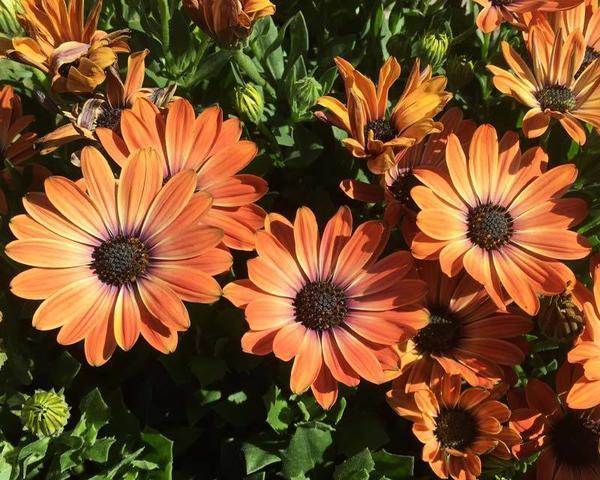

Seed pods on the grass form from mid-August. Flowers self-pollinate. If self-seeding is not in the plans, you need to cut the boxes. When planning to use the seeds, the pods are harvested in a dry, cracking state.
In the photo dimorfoteka resembles a chamomile. This is the popular name for the flower. The name is used with the adjective African. It hints at the homeland of Dimorphoteka. But the appearance of chamomile indicates that it belongs to the Asteraceae family.
Being African, in the conditions of the Russian climate, the flower is an annual. therefore planting dimorphoteka carried out on personal plots and in flowerpots exposed for the summer to the entrances, to city flower beds and balconies. However, there is not always a need to re-stock seedlings for the coming season. Dimorphoteka often reproduces by self-seeding.
Dimorfoteka flowers are herbaceous. The buds are based on a bushy base up to 60 centimeters high. The stems of the plant are erect. The buds on them reach 10 centimeters in diameter. The color of the flowers is different. There are dimorphotes of all shades of red, yellow, blue, lilac and white.
The bud fades in 5 days, being replaced by new ones. A feeling of continuous flowering is created. Due to the bushiness of the stems and the abundance of buds on them, the planting of dimorphotes looks like a kind of chamomile carpet. It covers the ground from June to September.


The leaves of the plant are elongated. If not for the notches at the edges, the green plates would have been wide. However, the abundance of cutouts makes the leaves of the dimorphote look like stylized Christmas trees from children's drawings.
A root-rod is hidden underground. It rushes inward, drawing out moisture from there. This complicates the transplantation of adult Dimorphotecs. Have you ever dug up small pines? At a tree 30 centimeters high, the root goes at a right angle into the ground by about a meter. Dimorphotek has to dig 60 centimeters that way. However, transplanting adult grass is rarely practiced.
Requirements for the conditions of detention
The guest from South Africa is very fond of the sun. Not only that, her flowers only open when the sun is shining brightly. This is how the plant shows its frugality. In cloudy weather, pollinating insects do not fly, and the water evaporates from the petals.A closed flower saves not only water, which, apparently, is not enough in the plant's homeland. The consumption of pollen is also reduced, the production of which takes a lot of resources.
So dimorphoteka is a sunny flower, its aesthetic purpose is to create a festive mood, painting it in a variety of tones.
Dimorphoteka, as it has already become clear, is a drought-resistant plant, but it is still not a cactus. This small, bright flower can hold out for a long time during dry periods, but it does not store water in its stems and leaves. For this reason, dimorphoteka dies during prolonged drought.
The persistence of dimorphoteka is also manifested in the fact that it withstands frequent and strong winds well. However, this does not mean that delicate bright flowers can live in a heat blown by all the winds. They are just very patient and beautiful plants that fully manifest all their splendor in a comfortable environment.
As mentioned above, all types of dimorphotek do not like cold weather very much. These are still not desert dwellers, adapted to daily and, moreover, annual temperature drops of tens of degrees. They love constant heat and cannot tolerate short-term frosts, even with temperatures around zero.
Soil dimorphotek need well-drained, light, preferably with sand, but with a lot of organic matter. For example, to keep this plant on a windowsill, it is best to prepare a soil mixture consisting of leafy earth, humus, turf and sand, taken in a ratio of 1: 3: 1: 2, respectively.
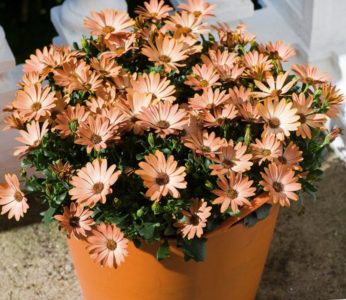

General characteristics of colors
Dimorphoteka belongs to the same Asteraceae family as sunflower, aster, chamomile, gatsania, osteospermum, gerbera. They form inflorescences-baskets, consisting of small tubular flowers and large reeds. These plants have a great similarity in the shape of the flower: the rounded center is framed by long and narrow oval petals, resembling a child's drawing of the sun with rays. Simplicity and noble grace are fully inherent in dimorphotek, and unpretentious care and abundant flowering have made this flower very popular among summer residents, gardeners and landscape designers.
The height of the dimorphote does not exceed 40 cm. After planting, it forms hemispherical bushes with dense foliage and numerous single peduncles. Instead of withered baskets, new ones constantly appear. Buds on long pedicels grow abundantly for two months. Flowers do not die during the first autumn frosts.
Dimorphotec corollas open only in sunny weather, closing at night and on a cloudy day. The diameter of the baskets is 5 - 8 cm. The reed petals are numerous; they are located rather densely, slightly overlapping each other. Below the corollas are lilac-purple, and on the front side they are orange (bright or delicate), yellow, cream, apricot, salmon pink or white. The middle of the flowers are small, brown or yellow with a contrasting black-brown frame and a dark "eye". Some varieties have a lilac-purple center.
The assortment of Dimorphoteka is not very diverse. Modern cultivated plants are the result of hybridization of perennial natural species originating from the southern outskirts of the African continent. Most often, a pastel mixture of colors (under different names) is proposed for planting, as well as the Polar Star varieties (she is also White Radiance, Snegurochka, with white petals and a purple center) and Tetra Goliath (with bright orange corollas and a dark eye).
Accommodation of variegated relatives of the aster
Planting and caring for them in the open field does not require much effort. However, a lot depends on where you want to place your bright flowers.
Florists choose a place for planting ornamental plants based on the following considerations:
- there is a free space and it needs to be filled with something;
- create a composition to the delight of yourself and the envy of your neighbors;
- love for a particular type of plant, forcing to sacrifice a lot for the pleasure of admiring some flower.
Of course, the desires and preferences of gardeners may be different, but in any case, they all fit into these three points.
If your impulses are controlled by the love of dimorphic plants, then you can create a separate flower bed or a whole motley meadow, where each species will contribute to creating a unique cheerful atmosphere of your garden.
To do this, you only need to provide the plantings with plenty of sun, prepare suitable soil, scatter seeds and provide the most common care, consisting of weeding, rare watering, feeding and helping your pets fight for the life of those who consider dimorphotes as their food base.
This plant can be used to decorate borders, flower beds, in the center of which there are short-term flowering plants (for example, peonies or spireas), etc.
Dimorphoteka care
Seasonal care comes down to weeding and periodic moderate watering if the soil dries up. You should not get carried away with the supply of water: it is better to underfill than to pour. For a more lush flowering of dimorphotes, two or three root dressings can be given over the summer with a solution of a complex mineral fertilizer with a large proportion of phosphorus, potassium and trace elements. It is advisable to remove faded corollas: this technique stimulates the growth of new buds and prolongs the life of the bush.
Plants feel comfortable in high flower beds and rocky hills, when planted in wheels and in pyramidal structures. Due to its compact size, dense and abundant flowering, unpretentious care, Dimorfoteka is suitable for growing in flowerpots, for decorating balconies and terraces. Potted bushes must be protected from rain and periodically fed with mineral fertilizers.
The subtleties of growing flowers
This plant is bred outdoors using seeds. Sowing is usually done in May. Despite the plant's sensitivity to frost, there is no big risk in sowing in May, since these flowers grow only when sharp drops in temperature become extremely unlikely.
If the gardener has a desire to see early dimorphoteca flowers, cultivation is carried out using seedlings. In this case, flowering will begin from mid-June. To get strong seedlings, it is better to plant seeds in a greenhouse or in special containers in early April. This should be done under the film. Boxes or greenhouse beds should be filled with a versatile substrate that can be used for different types of plants.
After sowing seeds in moist and fertilized soil, the box or bed is covered with plastic wrap. You need to open the container only in extreme cases, for example, when mold or any pests appear. The air temperature in such a greenhouse should be about 16 ° C.
After 20 days, sprouts should appear. At this time, the boxes are transferred to where there is a lot of light, and in the greenhouse you need to start airing. When the sun is warm and shining brightly, the film is removed, and the seedlings are covered again at night.
When the sprouts give the first true leaf, they can be dived and transplanted one by one into peat or plastic pots, the diameter of which is no more than 5 cm.This is necessary so that the plant is finally formed and strengthened in a separate pot. It is in this form that they will need to be transplanted into open ground. Peat containers are immersed in the prepared hole, and the plant does not receive any damage. Plastic pots are cut, and a compressed lump of earth with intact roots is planted in the ground.
Dimorphoteca seedlings can be purchased at the market or in a special store.When buying seedlings, you need to pay attention to the condition of the sprouts. Specialists, in particular, give the following recommendations:
1. Before buying, if you are doing this for the first time, ask how exactly the sprouts of dimorphoteka look like. The label, the price tag and the seller's assurances, of course, are important information, but many summer residents then wonder, standing over the flower beds, what exactly they bought.
2. The sprouts should be firm, not elongated, the leaves should be evenly green. The roots of the plant should not grow through the drainage hole of the vessel.
3. Seedlings should be replanted for permanent residence only at the end of May, when the risk of late frosts tends to zero.
4. In a previously prepared hole, you need to pour at least half a liter of hot water with potassium permanganate (pale pink solution). This will destroy small pests, bacteria and fungi that could damage the delicate roots, as well as enrich the soil with potassium and manganese.
5. In 20 minutes after watering, the plant gently rolls down its top and pulls it out of the pot with weak pulling movements. If the sprout is in a peat pot, then it simply moves into the hole and sprinkles with prepared soil. If the seedling is in thin plastic, then the root ball is cut out and also placed in the hole. The distance between plants should be between 25 and 35 cm.
6. 5 days after planting, each sprout must be fed with nitrogen-phosphorus fertilizers or a weak solution of manure (0.5 kg per bucket of water).
The plant begins to bloom about 2 months after germination. If seedlings were planted, then you will notice the first buds two weeks earlier. The average flowering time is one and a half months.
Thus, dimorphoteques represent an interesting and creative option for decorating the space of a garden, a summer residence, a manor house, a balcony and even a window sill. If you are lucky and there are areas on your territory where the sun shines all day, then hurry up to fill them with colorful guests from South Africa. They will create an atmosphere of cheerfulness, filling the space with a variety of color palette.
An amazingly beautiful flower is unpretentious in care, strikes with its tenderness and fragile appearance, resembles either a chamomile or a marigold. Dimorphoteka is a very graceful plant, and at the same time, simple and unobtrusive. It comes from South Africa, so it is used to dry periods, it tolerates a long lack of moisture, it can adapt to any hot or temperate climate, it takes root well in the open field. Planting and growing these flowers is not a big deal for gardeners. Designers also do not leave dimortofeka unattended when decorating garden plots, city parks and other objects of the city-wide landscape, I mean. In the photo you can see adult flowering plants of different varieties.
Growing dimorphoteka and caring for it
The taproot of the plant manages to extract moisture from the depths even in dry times. It is not for nothing that Dimorphoteka has chosen the south of the continent in Africa. Excessive moisture in the soil is dangerous for the flower. The root can rot.
therefore growing dimorphoteka often preferred by summer residents who visit the site, as they say, once every five years. The owners of the estates know that African chamomiles will bloom and smell without watering and special care.
The unpretentiousness of the dimorphote is also expressed in its resistance to winds. Flowers feel great on a swept area. Therefore, African daisies are often decorated with estates in the steppes, desert areas.
Seeds are placed in open ground in May, and they are sown on seedlings at home in April. The room temperature should be around 15 degrees. Before germination, the pots are covered with foil. When the 5-6th leaves appear, the seedlings dive into separate pots.
So that the plants are in separate pots - conditions for purchased seedlings.It is also necessary to pay attention to the strength and turgor of the dimorphoteka and the cleanliness of the drainage hole. Seedling roots should not stick out into it.
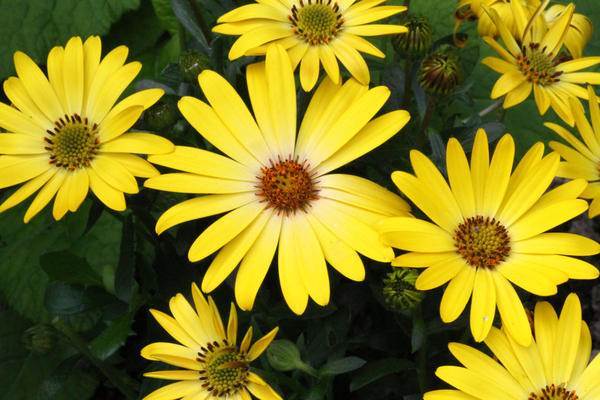

They will be difficult to retrieve. Meanwhile, the root system of African chamomile is sensitive, and it does not recover well if damaged. Therefore, seedlings are transplanted along with a clod of earth, minimally disturbing. 20-30 cm gaps are left between the plants.
In order to make the most of the ability of African chamomile to bloom for a long time, dimorphic seedlings or its seeds are planted in sunny areas. In the shade, the buds remain closed.
When choosing a place for planting, you must also take into account the nature of the soil. Dimorfoteka loves light and loose soil with an abundance of organic matter. Therefore, African chamomile is fertilized with organic fertilizing. Ordinary compost, manure will do.
Growing dimorphoteka in a pot, the soil is made up of equal shares of humus, turf, sand and leafy earth. If African chamomile is grown in the garden, it is logical to plant it next to other drought-resistant herbs, for example: Venidium, Geleotrope, Pelargonium.
Dimorphoteka care can be aimed at prolonging, stimulating flowering. Mineral dressing and timely cutting of withering buds help to achieve the goal. Then the roots stop supplying juices to them, the energy of which is spent on blooming new flowers.
Dimorphote structure, species, varieties and hybrids
A low plant of the aster family, cultivated as an annual, but can grow in one place for several years, multiplying by falling seeds.
Flowers - have petals of two shapes, hence the name: dimorph - two shapes, teka - place, capacity. The main petals are ligulate, they, in fact, form the basket of the flower, and in the middle there are small tubular petals.
Stems - branchy from the base, grow up to 60 centimeters, depending on the variety. On one stem, inflorescences are formed in large quantities, up to 30 pieces. The leaves have characteristic notches at the edges, one of the main varieties is called the notched dimorphote. The roots are long, pivotal, drought-resistant, do not tolerate stagnation of moisture in the root system.
Flower types
There are a little more than 20 types of flower. A species is understood as a set of physiological and morphological features. They overlap in related plants. Species are combined into genus. Plants inside them can interbreed with each other, giving viable offspring - hybrids.
The main types of dimorphote include:
- Dimorphoteka is hollowed out... Named for the shape of the leaves. The stems of the plant are bushy, branching from the ground, 30-40 centimeters high. The diameter of the inflorescences of the dimpled dimorphote is 5-7 centimeters. There are about 30 of them on each stem. The buds are colored yellow and open only in sunny weather.
- Rain African chamomile. This is a stunted form with a height of 10-20 centimeters. White flowers bloom at the tops of the bush. The bottom of the petals and the core of the buds are purple. Another difference between the rain dimorphote is the edge of the leaves, they are like velvet. The villi retain moisture.
- Tetra Polyarstern. Its peripheral petals are also white, but the core is blue and ringed with bright purple. The diameter of the buds is 8 centimeters. At the same time, the height of the bush reaches 40.
- Tetra Goliath. The species is famous for its large basket flowers. Their diameter reaches 10 centimeters. Flowers are painted orange, including heart-shaped ones. The bush itself stretches 60 centimeters. So dimorphoteka Goliath is large in all respects.
- Giant Mix. This is a medium-sized grass. She is bushy. Orange, yellow, pink flowers bloom on 30-centimeter stems at the same time.
Each species has varieties. They are ordinary, that is, obtained from plants of one category by selecting "individuals" with larger or brighter buds, a certain shape of the leaves and the nature of their surface.Seeds of varietal varieties give the same offspring.
There are also hybrids obtained from crossing between species. Such plants produce seeds from which parental copies are not obtained. Any dimorphotecs can grow in the second generation.
There are also so-called false dimorphotes. With them, the genus expands to 70 families. Example - dimorphoteka osteospermum... Unlike the true one, it is perennial even in Russian conditions. In addition, osteospermum is also a genus of plants. It is separate and includes about 50 species. However, outwardly they are all similar to dimorphotes. Hence the confusion.
Characteristics of the main varieties and hybrids
Dimorphoteka notched, orange
- the plant grows up to 40 cm, flowers are orange and yellow, one of the popular hybrids is characterized by white petals (Polaris).
Dimorphoteka notched
Dimorphoteka rain, or summer
- differs in its short stature, only 15-20 centimeters. Fans of decorating balconies with flowers prefer to grow this particular variety.
Dimorphoteka rain
- Tetra Goliath is a dense voluminous shrub with bright orange and yellow flowers;
- Jaint Mix - reaches a height of 30 cm, flowers with petals of different colors bloom on one plant: pink, yellow and orange, a very reproductive plant with abundant flowering;
- Tetra Polyarstern - flowers are large, about 8 centimeters, snow-white with a purple circle at the base, bush up to 40 cm high;
- Glazing White - white flowers with a middle contrasting dark color, a good specimen for planting on balconies and loggias.
Dimorphoteka is grown and cultivated in our climatic zone as annuals, it has a low threshold of frost resistance, and does not tolerate winter cold. The photo shows samples of different species and varieties of this wonderful plant.
Varieties of dimorphoteka
In temperate climates, the cultivation of dimorphotes is practiced as an annual, since plants that have overwintered in pots in the house do not give strong shoots and take root in a flower bed worse than those grown from seeds. In flower beds, you can find two natural forms of dimorphote - rain and notched, as well as their numerous hybrids.
Dimorphoteka notched
Dimorphotheca sinuata orange or notched (Dimorphotheca sinuata) is an annual plant reaching a height of 30-40 cm. The bush is hemispherical, densely leafy, with numerous erect shoots. Leaves are elongated, notched, not pubescent. It blooms in simple baskets up to 6 cm in diameter, located on the tops of strong pubescent peduncles. Long lingual petals are painted in a rich bright orange shade with a dark spot at the base. In the center are short tubular flowers of dense black-brown color. The cultivation of this type of dimorphote in culture has been carried out since 1798.


Dimorphoteka rain
Dimorphotheca summer or rain (Dimorphotheca pluvialis) is also an annual, growing on average up to 15-20 cm in height. Leaves are oblong, pubescent. The inflorescence is a basket with a diameter of up to 8 cm. The outer flowers with long, elongated tongue-shaped petals are painted in a snow-white color, passing at the base into purple-violet. In the center are small tubular flowers of a golden brown hue. This species has a pleasant, unobtrusive aroma, and it is exuded both by flowers and leaves. Rain gardeners have been growing dimorphotes since 1752.
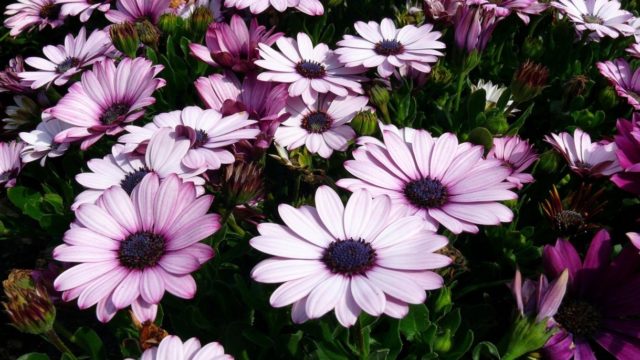

Dimorphoteka hybrid
The surprisingly fragile and delicate flower of Dimorphoteka could not go unnoticed by breeders. Re-pollination of the two natural species described above made it possible to obtain new interesting specimens. Photos of dimorphotes are full of richness of colors and tones. Over the years of breeding work, a large number of varieties have been consolidated.
- Dimorfoteka Polar Star. Lush bush of hemispherical shape.The petals are white with a purple-violet base, the center is dark brown. The culture of the variety is easy to grow and is one of the most popular.
- Dimorfoteka Snegurochka. Compact, densely leafy bush. It blooms from June until the first frost with snow-white inflorescences with a burgundy rim at the base, the center is almost black.
- Dimorfoteka Shine of the star. A low-growing bush that grows 25-40 cm in height. The petals can be white or pinkish, the center is a deep dark brown.
- Dimorphoteka Flower nectar. Hemispherical dense bush with dark green leaves, up to 30 cm tall. The petals are yellow, cream or orange, the core is a contrasting burgundy brown. The diameter of the inflorescences is about 6 cm.


- Dimorfoteka Laughing girl. The plant of this variety is tall, up to 50 cm tall. It blooms with medium-sized, bright orange chamomiles that exude a delicate aroma. The culture of the variety is easy to grow.
- Dimorphoteka Tetra Polarstern. The bush is compact, grows up to 30-40 cm in height. Inflorescences are snow-white with a dark purple center, 6-8 cm in diameter.
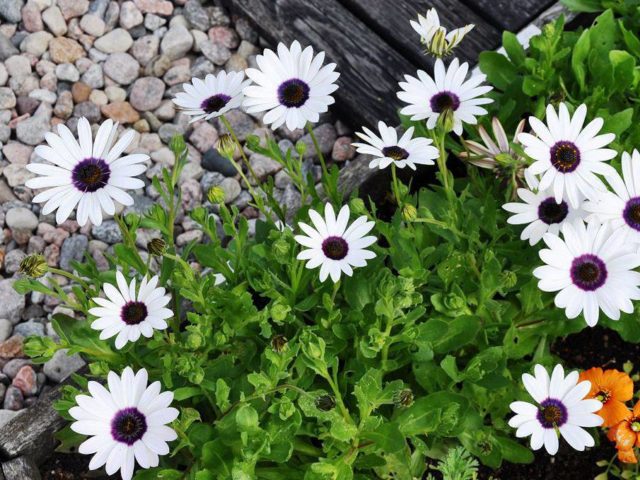

- Dimorphoteka Tetra Goliath. A voluminous bush with numerous stems on which pubescent oblong dark green leaves are located. Height - up to 40 cm. It blooms with large (5-7 cm) orange daisies with a dark red-brown core.
- Also in stores you can find a mixture of seeds from different large-flowered varieties - Giant Mixed.


Plant propagation by seeds
Dimorphoteka pollinates independently, it does not require insects, it does not need to apply manual pollination. The seeds ripen annually at the end of summer, the capsule opens easily, and they spill out on the ground, but in the cold winter they die without giving spring shoots. In order to preserve the planting material until next year, the seed pods must be cut off as soon as they darken and put them for ripening.
Advice. Collect seeds for propagation from the lush bushes, which give early abundant flowering in summer.
The seeds should be stored in a dry, dark place until they are planted in open ground or for seedlings. In the open field - this is April-May, for seedlings - the end of March.
Collect seeds to plant next spring
Collection and preparation of Dimorphoteka seeds
To grow a dimorphoteca from seeds, it is not at all necessary to buy planting material annually. You can collect the seeds yourself, the main thing is to adhere to a few simple rules.
Dimorphoteka belongs to the self-pollinating species. The seed pods begin to ripen in mid-August. As soon as they start to darken and get enough sleep, you need to start collecting seeds. If the seed bolls of Dimorphoteka are cut off immature, they must be dried in a dry, shaded place at room temperature. The dried seeds are put in paper bags or sacks made of cotton fabric, on which it is desirable to write the date of collection. Dimorphoteka seeds germination lasts for 2-3 years.
Advice! Experienced gardeners who have been growing a dimorphoteka flower from seeds for more than one year recommend taking planting material from the largest inflorescences that have blossomed earlier than others.
Dimorphoteka seeds are small enough - about 500 pieces per 1 g. In central Russia, dimorphoteka gives a friendly self-seeding, the seeds tolerate winter cold well, and the grower can only thin out the spring seedlings in order to prevent thickening of the plantings.
Depending on the region, growing dimorphoteka is possible both by seedling and non-seedling methods. In the south of the Russian Federation (in the Crimea, Krasnodar Territory and Stavropol Territory), seeds are sown directly into open ground. In areas with a harsh climate, as well as to achieve flowering at an earlier date, dimorphoteka is grown for seedlings.
How to plant, care for and feed Dimorphotek
The main agrotechnical conditions for growing this plant are:
- Choosing a landing site. Preference should be given to a well-lit place, but if the plant is in the shade for a short time during the day, it will easily endure it.
- Soil composition. The main conditions are a high content of sand (on uncultivated lands, dimorphoteka grows in pebble, sandy soils) and well-fertilized soil substrates.
- Free space. The plant is bushy, after the appearance of the first shoots, thinning should be carried out, leaving well-developed seedlings at a distance of 25 centimeters from each other.
Attention! When planting dimorphoteka to other flowers, choose plants that are similar in drought tolerance so as not to protect them from excess irrigation moisture and its stagnation in the soil.
Flower care is minimal:
- watering is done once every 3-4 days, in rainy weather, in order to prevent stagnation of water at the roots, it is necessary to drain the area, removing excess moisture;
- regular loosening and weeding from weeds;
- removal of dried leaves and flowers;
Choose a well-lit landing site
- top dressing during the flowering period - potash-phosphorus fertilizers are applied once a season, organic matter - only before planting.
Advice. To extend the flowering period, cut off dried and wilted buds in a timely manner, this will make room for new ovaries.
Pests and possible diseases of dimorphoteka
When decided plant dimorphotek, you need to prepare for its protection from pests and diseases. They can be gray rot or mites. The first refers to fungal infections and develops with excessive soil moisture.
Therefore, it is important to water Dimorphoteka every 4-5 weeks, even in dry weather. However, it is important not to overdo it, since mites are activated just at the minimum humidity. Healthy and strong plants withstand the onslaught. If African daisies wither from thirst, turn yellow, it is easy for ticks to “take the bastion”.


In order to prevent the defeat of the dimorphoteka, gardeners carry out preventive measures:
- soak the seeds before planting for half an hour in a solution of potassium permanganate, fungicides or formalin
- sprinkle plants with garlic, onion, tomato and potato tops
- loosen the earth under the flowers
- systematically weed dimorphoteka, because weeds take useful substances from the soil, weakening the flower and shading it with their stems
Observing the rules of prevention, you can forget about the diseases of African chamomile. All types and varieties of plants are resistant to ailments.
How to protect dimorphoteka from diseases and pests
Prevention is the best means of protecting a plant from being damaged by fungal diseases, and spraying with infusions that repel pests can be used against pests, having prepared them according to folk recipes.
To prevent the plant from getting sick, the seeds are treated with a solution of potassium permanganate before planting, soaking them for 30 minutes; formalin, fungicides and other drugs of a similar effect can be used for the same purposes.
Infusions and decoctions for repelling insects are prepared from garlic, onions, tomato and potato tops, infusing them in boiling water for 3-4 hours.
This flower itself has a high resistance to diseases and insect pests, using preventive measures, gardeners will not have big problems in the fight against such phenomena.
Outdoor care rules
Growing dimorphoteka from seeds implies regular watering, loosening, weeding, feeding. Performing these simple manipulations, you can achieve excellent results, even without experience in floriculture.
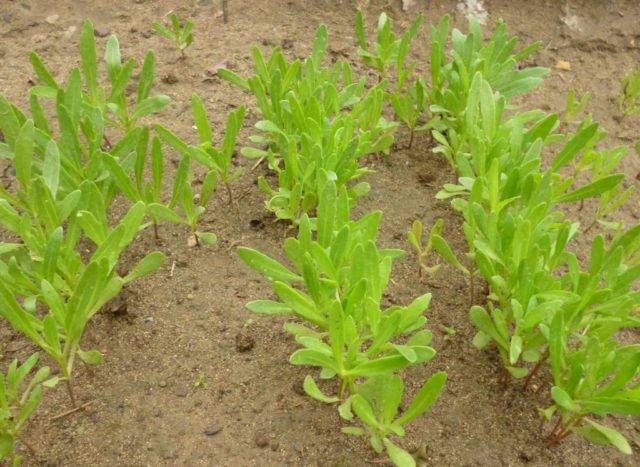

Watering
Cape daisies do not respond well to excessive watering. In the absence of precipitation, dimorphoteka is watered once every 5 days, the top layer of the soil by this time should dry out by 3-4 cm.
Top dressing
For a lush flowering of a dimorphoteca grown from seeds, it needs to be fed regularly.The first time fertilization is applied 2 weeks after transplanting, then the interval between fertilizing is 3-4 weeks. With the onset of budding, dimorphoteka is stopped to feed. As fertilizers for growing dimorphotes are used:
- superphosphate;
- potassium nitrate.
Sanitary cleaning
In order to prevent fungal diseases, as well as to stimulate the flowering of dimorphoteka, wilted flowers are pruned. Also do with dried and yellowed leaves.
Disease and pest control
Dimorphoteka grown from seeds through seedlings is little susceptible to any diseases. If the rules of agricultural technology are violated, the cultivation of dimorphoteka can be overshadowed by the appearance of gray rot, which manifests itself in the form of brown spots and plaque on the stems and leaf plates. To stop the spread of a fungal disease, watering is reduced, plantings are thinned out, the flower bed is treated with a solution of Bordeaux liquid or other copper-based preparations.
They were created by nature to decorate gardens
Decorators, landscape designers, home garden designers very often use dimorphic flowers for their creative ideas. This unpretentious plant fits quite organically into any floral arrangement.
Dimorfoteka in landscape design
Due to its low height, it is suitable for decorating roadside curbs in parks, in multi-level flower beds it serves as the lower floor, favorably highlighting taller plants, without obscuring them from the views of visitors to gardens and parks.
Dimorfoteka in landscape design
Dimorfoteka is often used by landscape designers to decorate the curbs in squares and parks. Gradually expanding, the bushes completely cover the ground, forming a dense, bright curtain. Delicate and touching African daisies can fit into many compositions, be it an alpine slide or a multi-level flower garden. Often, dimorphoteka is planted in flowerpots, at the entrances to the building, and cultivation in hanging pots also takes place.
White-flowered varieties of dimorphoteka go well in a flower bed with such annuals as:
- petunia;
- pelargonium;
- nasturtium;
- ageratum;
- acroclinum;
- heliotrope;
- venidium.
Dimorphic varieties with bright, catchy shades are interestingly combined with many annuals, also grown from seeds. When creating compositions, you need to take into account the peculiarities of growing each crop. In the case of growing a dimorphic plant, its neighbors in the flower bed should be drought-resistant and light-loving. Often planted next to dimorphoteka:
- alissum;
- arctotis;
- lobelia.
Dimorfoteka: features of growing and care
When I needed an unpretentious beautiful plant for a balcony box, I opted for Cape marigolds or, in scientific language, dimorphotek. Why exactly on it? I'll tell you now.
Unpretentious dimorphoteka does not lose its attractiveness throughout the growing season
Dimorphoteka belongs to the Aster family, in total there are 20 species in nature, mainly growing in the countries of South Africa. It is an unpretentious annual or perennial plant. In the middle lane, perennial dimorphoteca is cultivated exclusively as an annual.
Dimorphoteka is attractive not only for its touching flowers, but also for the fact that it does not lose its decorative effect throughout the summer - it blooms with a luxurious "carpet" from June to August. It grows in height up to 60 cm; inflorescences are simple baskets, the diameter of which can reach 6-10 cm. Among the abundance of dimorphic colors, it is easy to get confused even for an experienced gardener: yellow, apricot, orange, bright and light pink, lilac, white and even pale blue.
Sowing dimorphoteka
It is possible to sow dimorphoteka directly into the ground in May. To get stronger plants that will delight you with flowers from the beginning of June, it is better to grow seedlings.
Dimorphotek can be sown directly into the ground. Photo from the site svoimi-
In early April, I sow dimorphoteka seeds in a small cold greenhouse - under a film. A few years ago I bought a couple of plastic boxes in which early strawberries and grapes are transported, which I use instead of greenhouses. I fill these boxes with a universal substrate, sow seeds, cover an impromptu greenhouse with foil. Within 2-3 weeks (at a temperature of about + 15 ° C), the seeds germinate. I let the sprouts of the dimorphoteka grow a little stronger, then I dive them into small (about 6 cm in diameter) plastic pots.
Dimorphic seedlings. Photo from the site svoimi-
If you did not have the opportunity to sow dimorphoteka seeds yourself (and this quite often happens among gardeners, who have already forced the whole house, garden and backyard plot with bowls with vegetable crops), you can purchase ready-made seedlings. Please note the following when purchasing:
- each plant should be in a separate container:
- sprouts must be strong;
- the root system must not grow into the drainage hole.
I transplant seedlings to a permanent place only at the end of spring, when the warm weather is finally established. I do this very carefully, transferring the plant along with the earthy clod, trying not to disturb the roots, which, even with the slightest damage, are poorly restored. I maintain the distance between the plants at 20-30 cm. Flowering begins 7-8 weeks after germination and lasts about 35-70 days.
Botanical description
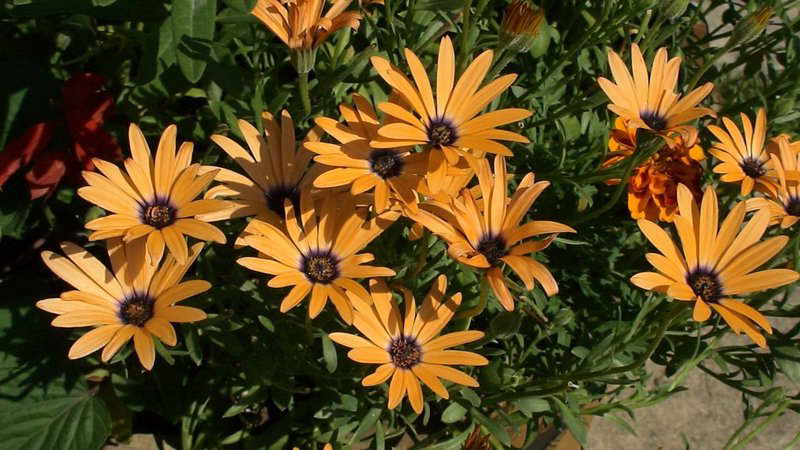

Dimorphoteka photo and growing in the garden
Plant height is 40-60 cm, stems branch well. The leaf plates are oblong with jagged edges. Stems and leaves are pubescent.
Dimorphoteca inflorescences are baskets, simple. The colors are in snow-white, sunny yellow, apricot, orange, lilac, pink, less often - blue, the core has a contrasting shade. Reed petals shine in the sun. The diameter of the inflorescences is 5-10 cm.
The botanical name of the plant is formed by two Greek words, translated as “two forms” and “container, container”. Other unofficial names of the plant: Cape marigold, Cape chamomile, African chamomile.
To protect pollen from moisture, plants regularly close their petals at night, the same happens in rainy, cloudy weather.
Florist reviews
Hozyaika-2
You can sow in the ground at the end of April. Dimorphoteka loves loose soil and the presence of sunlight. You can grow through seedlings, but you need to do this a month earlier.
Zosia
It is better to sow immediately in place, the transplantation somewhat slows down further development and flowering. Prefers light, breathable soils.
Dimorphoteka photo of flowers
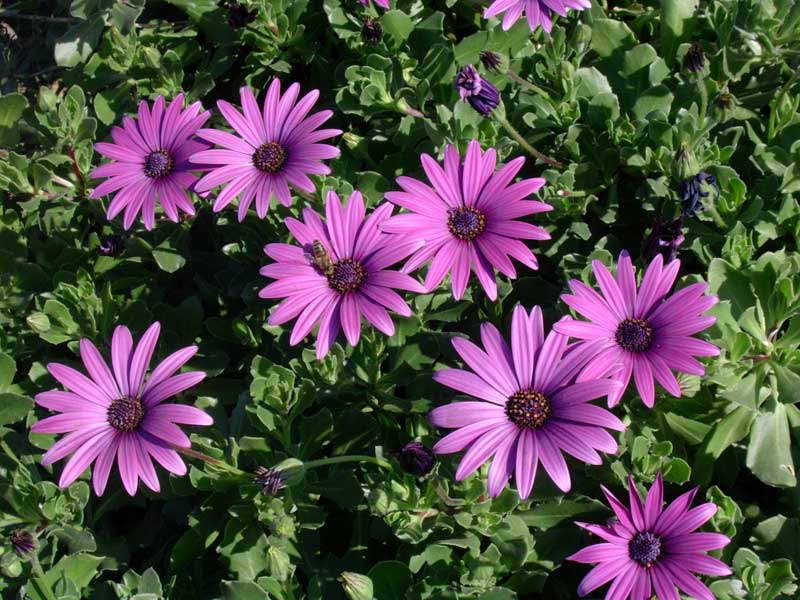

Dimorphoteka photo of flowers in the garden
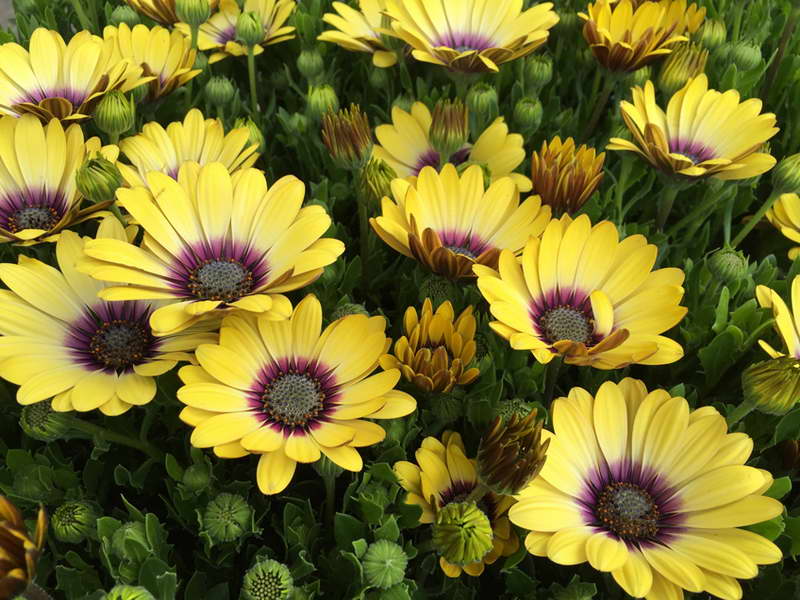

What does a dimorphoteka photo look like
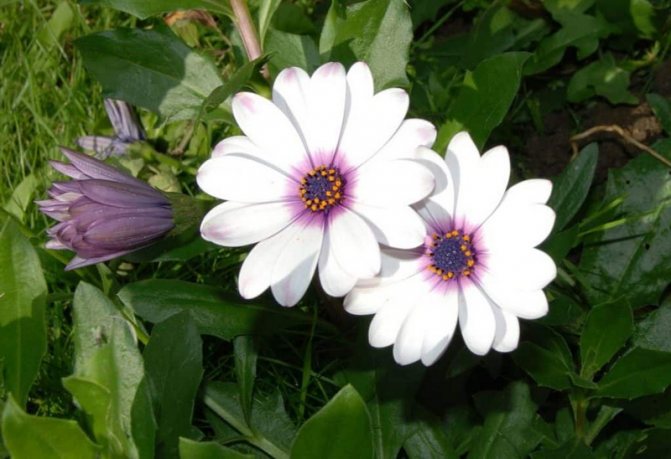

Dimorphoteka in the garden photo
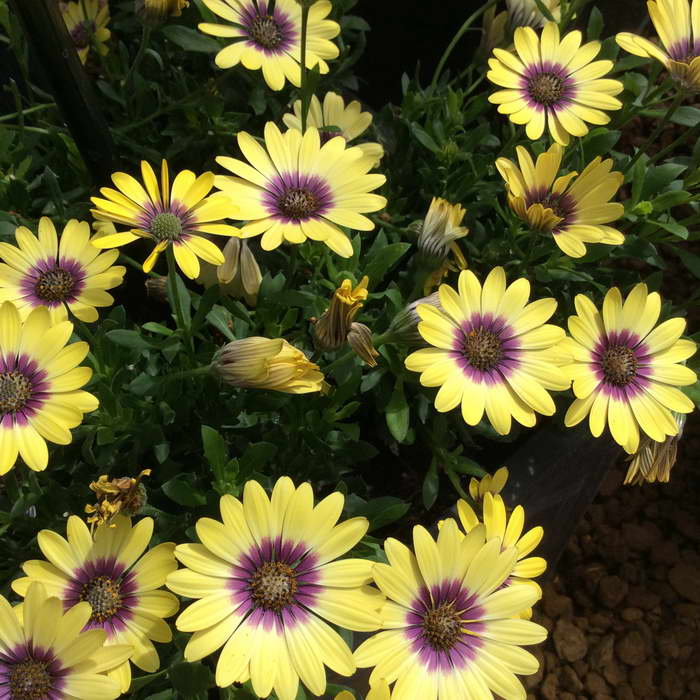

Dimorphoteka growing from seeds when planting a photo of flowers
Flowering features
Graceful multi-petal "chamomile marigolds" dimorphotek regularly close their petals at night. To protect the pollen from moisture, they do not unfold even in cloudy, and even more so, rainy weather. Therefore, the place of mass planting of these plants lives in its own mobile rhythm, now folding and green, then opening and blooming, so that it can serve as a kind of clock or barometer-weather predictor. These flowers retain their freshness for a long time when cut.


Dimorfoteca regularly cover their petals at night
Watering dimorphoteka
Since the plant belongs to the class of drought-resistant, it very poorly tolerates waterlogging of the soil and may die. For this reason, watering should be systematic and carried out every five days.
If the summer is rainy, there will be no need to water the crop. After watering, you should loosen the soil and be sure to break through the weeds.
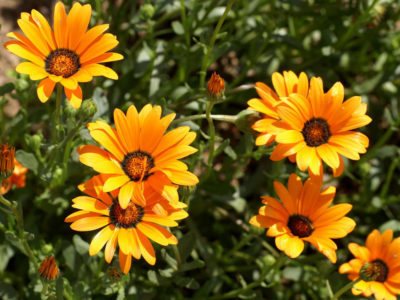

Seeds - purchase and collection
Planting and growing dimorphotek is a popular direction of phytodesign.Therefore, their seeds are supplied by numerous agricultural firms. The best reputation in the domestic market is enjoyed by:
- "Aelita";
- "Gavrish";
- "SeDec";
- "Search";
- "Russian vegetable garden".


Dimorphoteka seeds
In the open ground of the middle lane, the seeds of these unpretentious plants ripen successfully, overwinter in the soil and sprout self-sown in the spring. To put this process under control and get high-quality seed on their own, from the earliest, abundantly flowering specimens, dried baskets are cut off and sent to ripen indoors. Elongated curved seeds from the perimeter of the basket are noticeably different from the central, flat ones. Seed material remains viable for two years.
Brief description of the plant
Dimorphoteka is a low plant intended for growing on a personal plot, in flowerpots, rabatkas, on loggias or balconies. But before growing Dimorphotek from seeds, it is important to familiarize yourself with the rules of planting and subsequent care.
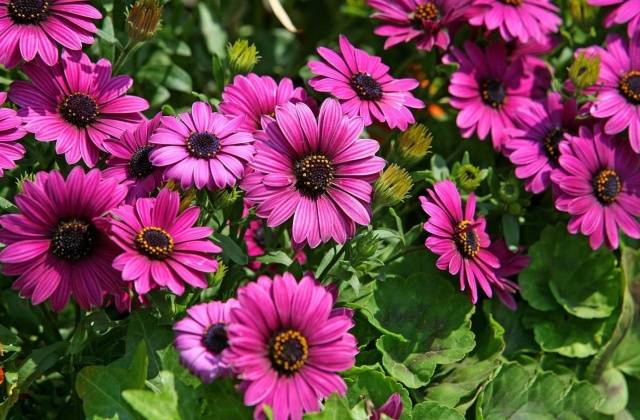

The homeland of flowers belonging to the Aster family is South Africa. Occasionally, for the fact that the Dimorphoteka baskets look like Calendula flowers, it is called "Cape Marigolds" or "Cape Daisies". Dimorfoteka appeared on Russian household plots relatively recently. But growers have already noted the benefits of this unique plant, which are as follows:
- ease of growing;
- long flowering period;
- resistance to many diseases and pests;
- versatility.
In its historical homeland, Dimorfoteka, growing in the wild, is a perennial. But flower beds and flower beds are usually decorated with annual plants bred by breeders.
Interesting! When growing Dimorphoteka from seeds, it is important to remember that flowers do not tolerate transplanting well, so it makes no sense to transplant them into boxes and flowerpots with the onset of autumn.
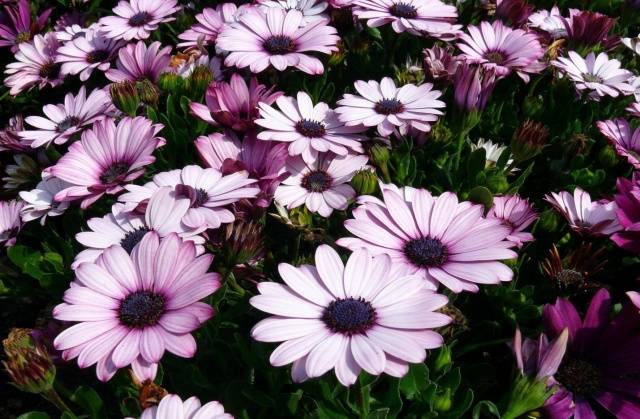

The flowers of Dimorfoteka resemble modest, but beloved by everyone, large, garden daisies. Here are just the colors of the reed petals are presented in a variety of colors. They can be snow-white, pale cream, yellow, orange, pink, burgundy, lilac. The middle of the flowers are mostly several shades darker than the petals.
The first buds appear on Cape Marigold 3 months after planting the seeds. Dimorfoteka blooms violently in sunny weather. Bright, beautiful flower beds are like a fabulous carpet. In cloudy weather and with the approach of evening, the inflorescences close.
The height of Dimorphoteka varies from 20 cm to 40 cm, depending on the variety. The size of flowers is from 6-7 to 10 cm in diameter. Lush and long flowering Dimorfoteka grown from seeds will delight flower growers from mid-June to late August.
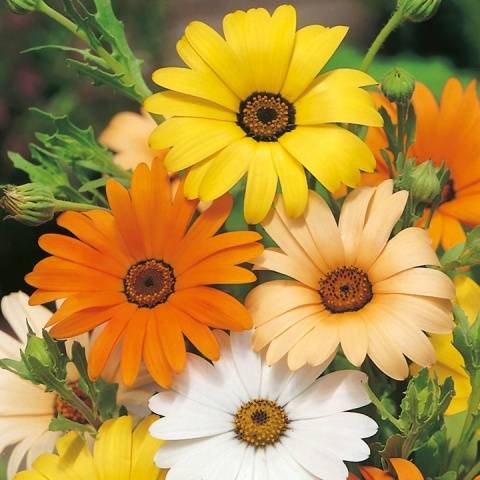

Thanks to the tireless work of breeders, over the past decade, more than 20 species of Dimorphoteka have been bred, the color range of which is simply amazing. But the most widespread at the moment on the territory of Russia are only three types:
- Dimorphoteca notched. Differs in the peculiar shape of the leaves. Plant height 30-40 cm. The size of flowers is up to 7 cm in diameter. Orange or yellow inflorescences with a dark brown center. Dimorfoteka blooms very profusely, covering the backyards with a bright, luxurious carpet.
- Dimorphoteka rain. Plants are almost half as low, up to 20 cm in height. The petals are white, dark purple at the base. The underside of the petals is also purple. The size of the inflorescences can reach up to 10-12 cm in diameter.
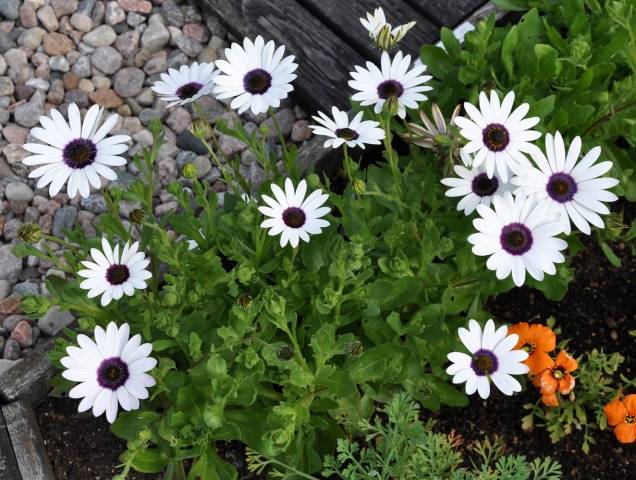

- Dimorphoteka is hybrid. An annual plant from 15 to 40 cm high. Baskets of flowers up to 7 cm in diameter can be of the brightest color: yellow, azure, pink, pale lilac, orange, purple. Most often, seeds for growing Dimorphoteka hybrid are sold in mixtures.
Interesting! Often Dimorphoteku is called a "natural barometer", because they react to the slightest changes in the weather, closing the buds.
See how beautiful Dimorfoteka flowers are
Botanical characteristics of Dimorphoteca
According to botanical characteristics, dimorphoteka is a small annual or perennial strongly branching plant 30 - 40 cm high. It has straight, sometimes creeping shoots. The root system is pivotal. The roots go deep underground, hence the plant's ability to easily tolerate prolonged drought.


The leaves are elongated, ovate, notched, slightly pubescent, dense, dark green.
The inflorescences are simple, sometimes double, up to 8-10 cm in diameter, reminiscent of a chamomile.


The ligulate flowers are white, yellow, burgundy or orange, the tubular flowers are dark. The petals are elongated, narrow, pointed. The buds open only in sunny weather. To date, terry and semi-double forms have also been bred. This culture blooms at the end of June - in July and blooms before the onset of frost. The lifespan of each inflorescence is 5 - 7 days, after which it fades, and a new one is formed in its place.
After flowering, the fruit is formed. It is noteworthy that this culture is capable of reproducing two types of fruits.
The first is a curved ribbed achene with a pointed base, the second is a flattened smooth achene. Seeds are large, up to 0.7 cm long, have a high germination capacity. Can be stored in a warm, dry place for 2 - 3 years.
Perennial plants are most often used as annuals.
Dimorphoteka is one of the most common ornamental plants in domestic flower beds. Its popularity is due to the rich color range of varieties, unpretentiousness to growing conditions, and a long flowering period. The plant is versatile and suitable for creating a variety of compositions of any complexity.
The description of the dimorphoteca flower is supplemented with the following photo, where parts of the plant are visible and its characteristic features are traced:
3. Varieties:
3.1.Dimorphotheca notched - Dimorphotheca aurantiaca
Compact herbaceous flowering plants up to 30 cm high with branched strong stems Leaves are green, linear, narrow, fragrant when damaged. The leaf blades are entire. The flowers are large, reminiscent of a chamomile, with many long petals in shades of orange, coral, yellow.
↑ Up,


Soil for dimorphoteka
The soil for the plant should be air and permeable, nutritious and neutral in acidity. If the garden soil is too dense and lacks nutrients, it must be mixed with sand and humus before planting the plant.
So that water does not stagnate in the ground, in each planting hole, when planting dimorphic plants in a seedling way, you need to put drainage from a thick layer of fine expanded clay.
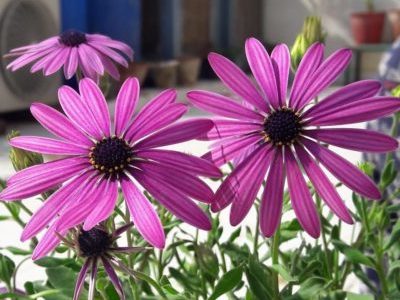

Landing technology
If you plan to grow flowers in the open field, then you need to prepare a site in advance for planting seeds. There are two ways to grow dimorphoteka:
- planting seeds in open ground,
- transplanting seedlings.
A plant with a vulnerable root system must be transplanted carefully. The place for planting should be not darkened, the flower needs sunlight.
To shorten the growing season, cultivation is carried out through seedlings. To obtain strong and healthy young animals, seeds are sown in early April in boxes or prepared containers.
Planting seeds for seedlings
To get the first flowers, it is better to grow dimorphoteka seedlings already in June. This requires:
- Prepare a substrate consisting of humus, peat, sand, turf. Add vermiculite for drainage.
- Stir the soil thoroughly.
- Spread the seeds over the surface of the substrate and sprinkle them, lightly tamping the soil.
The container should be covered with foil and left in a room with a temperature of 14–15⁰ С. After 16–20 days, the first sprouts will appear, which must be planted in separate containers.
Seedlings are best grown in peat pots or tablets. They do not need to be removed when transplanting seedlings to the site.
Hardening
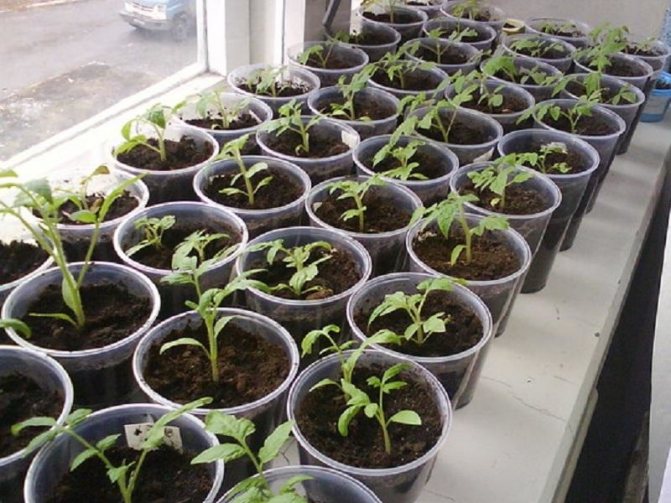

Seedlings require hardening (stratification). After 15 days after germination, you need to start airing the room. Windows should first be opened for 50-60 minutes. This interval should be gradually increased to 3-4 hours. After a week, containers with seedlings can already be taken out to an open balcony or street for 1-2 hours.
Landing in open ground
It is necessary to plant seedlings on a sunny site after the establishment of warm days. The plant is rolled into the ground along with a lump of earth. The soil can be prepared in the fall by digging and fertilizing it. The distance between the shoots should be at least 25 cm. The roots should not be damaged, they are very fragile and will take a long time to recover.
Seeds are planted at a steady night temperature above 10 ° C. Sequence of work:
- Make 5 cm deep furrows on the flower bed (interval 25 cm).
- Fill them with warm water.
- Lay out the seeds.
- Cover with dry soil.
- Sprinkle the ground with a spray bottle.
It is important to remember that dimorphoteka tolerates drought more easily, and not waterlogging of the earth.
Top dressing
To feed the flower, you can use a ready-made complex mineral composition. Before the buds appear, it must be applied at least 2 times. Mineral dressings with a complex composition should not be used. They will cause the leaves to grow, but not the flowers. For this purpose, superphosphate and potassium nitrate are suitable. They are introduced in small portions during the formation of buds. If flowering has begun, then you do not need to fertilize the plant.
Care after landing
Dimorphoteca planted in open ground needs weeding only at the very beginning of growth. An adult bush is able to suppress weeds on its own. It should be watered regularly, but always when the top layer of the soil is completely dry.
The seeds in the pods will begin to darken and sleep well in the last summer month. This is the best time to collect.
The flower can be used as a perennial. To do this, in the fall, you need to transplant the bush into a container and leave it in the house until spring. When the frost has passed, it will be possible to take the plant outside.
How to care
| Watering
|
| Top dressing
|
| Pruning
|
Are dimorphoteka and osteospermum the same?
Yes. Other flower names - osteospermum, African chamomile. It is a pity that even the perennial species of the thermophilic beauty are cultivated in the conditions of central Russia only as an annual. Nevertheless, light frosts (spring or autumn) are not afraid of dimorphoteka. Due to the long multi-colored flowering, dimorphoteka will interest even sophisticated gardeners, because you always want to plant something new and interesting on the site.
Dimorphote pruning
Pruning the plant is needed to maintain decorative properties, prevent self-seeding and the development of putrefactive diseases.
To stimulate flowering and maintain decorativeness, you should cut off the faded buds, and to avoid self-seeding, you need to remove the seed pods in time.
Thinning plantings by trimming side branches and weakened bushes will help the grower prevent the development of gray mold.


Further care
"Cape marigolds", originating from Africa, easily tolerate arid conditions. Therefore, they are not watered too often - after the earth dries up three to four centimeters deep.In thickened and waterlogged plantings, at low temperatures, the plants are affected by fungal gray rot: brown spots appear on the leaves and shoots, which are covered with a characteristic grayish bloom. In this case, spraying with Bordeaux mixture and copper-containing preparations, thinning the planting and reducing watering helps. Insect pests are practically not found on "Cape marigolds".
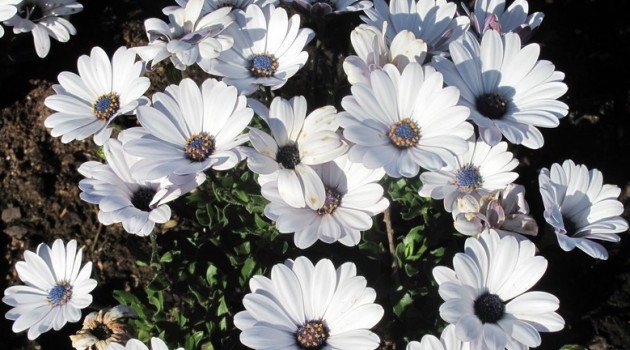

Dimorphoteka does not require frequent watering
The soil, especially after watering, is regularly loosened and, until the dimorphotes have grown, they are systematically and thoroughly weeded.
Top dressing with organic and / or mineral fertilizers with a predominance of potassium and phosphorus is carried out:
- in the open field - soon after disembarkation, and then, during the summer season, once or twice a month, during the period of mass budding;
- in container culture - once every two weeks.
To prolong and enhance flowering, withered "marigolds" are promptly removed. Particularly resistant types of dimorphotek are capable of blooming until autumn, withstanding frosts of 5 degrees.
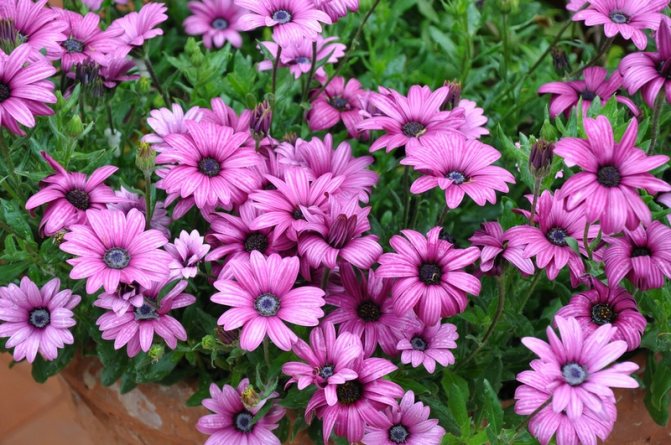

To prolong and enhance flowering, wilted "marigolds" are promptly removed
Sometimes the most valuable bushes of perennial varieties are carefully dug up in order to keep them in a bright and warm room in winter. However, due to the general fragility of the root system and the particular vulnerability of the taproot, such attempts often end in complete failure. Dimorphotek is much easier and much more reliable to grow from seeds in an annual mode.


Basic conditions for growing dimorphoteka
Unpretentious, drought-resistant, blooming profusely all summer long, dimorphoteca is easily propagated by seeds, including those collected independently. For earlier flowering, seedlings are sown in early spring, followed by careful placement in permanent places. Plants obtained from seeds in the open field bloom one month later.
Diseases.
Pests are rarely interested in Dimorphoteka, and it is resistant to most diseases typical for plants. But, problems can arise due to excessive watering or stagnant moisture. Excess water can cause the development of fungal diseases and root decay, due to which the plant dies in a matter of days. Affected plants must be destroyed.
Dimorphoteka is a versatile flower with minimal maintenance requirements. The advantage of a flower is that it can delight with flowering in the warm season, and then serve as an ornament on the winter windowsill.
Description
Dimorphoteka is a genus of plants belonging to the Asteraceae family and includes about 20 species. The root system is pivotal with a small lobe of suction roots at the end. Leaves are simple in shape or pinnately-divided, with smooth or carved edges, with and without pubescence. Some species form a basal rosette, while others have stems with alternate leaves.
Inflorescences-baskets, formed singly at the ends of the shoots. Reed flowers (what many mistake for petals) with a brightly colored top and a dark bottom. The tubular flowers (directly in the middle) are small, yellow or dark (brown, purple, black). Single-row inflorescence wrapper. The fruit is a flattened achene without a tuft characteristic of Compositae.

